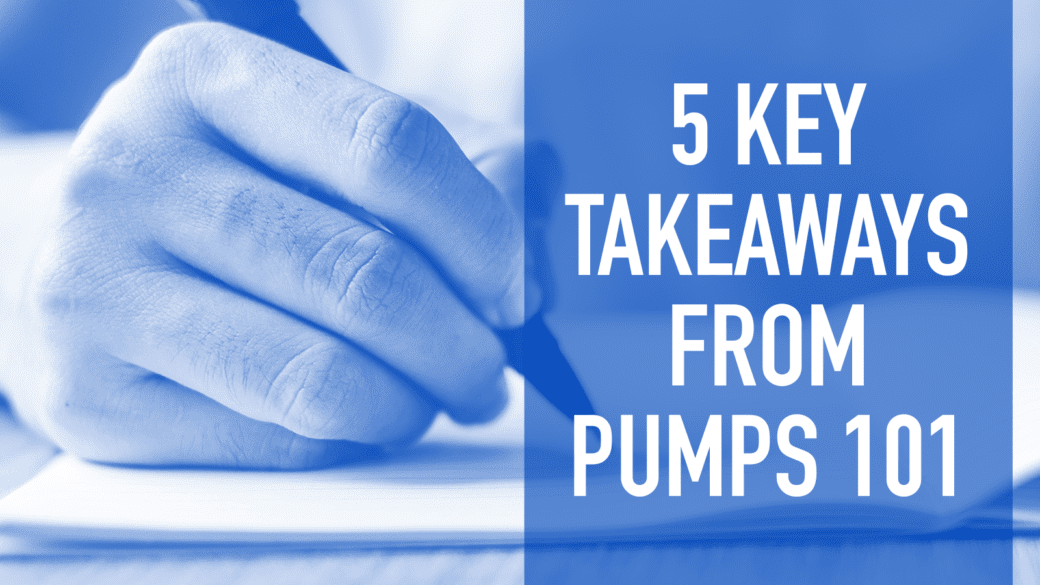From reading pump curves to preventative maintenance plans, we break down the top 5 takeaways from our Pumps 101 training.
Service Pump & Supply has more than 40 years of experience serving the municipal, oil and gas, industrial, and mining industries. We recently launched a series of free Pumps 101 workshops where our expert instructors taught water and wastewater professionals of all experience levels about pumping technologies. The training highlighted the basics of maintaining and operating pumps, blowers, controls, and valves. Workshop attendees had the opportunity to earn continuing education credits from the states of Ohio, Kentucky, and West Virginia.
Missed our in-person workshops? These are our key takeaways and lessons learned from Pumps 101.
1. Choose the right pump for the job
Pumps are one of the most commonly used machines in the world and come in many sizes, from microscopic for use in medical applications to large industrial pumps. So, before you can determine the best pump for your job, it’s important to have a basic understanding of the different types of pumps available. Selecting an over- or under-powered pump or one made with the wrong material can not only hurt your results, but may cost additional time, money, and resources.
| Pump Type | Description | Key Features | Uses |
| Centrifugal | Moves fluid through the pump with impellers | Designed to pump a wide range of volume, head output, and various liquids utilizing special materials of construction | Best for higher flows and for lower viscosity liquids |
| Piston | Utilizes pistons or plungers to move and develop high pressure | Builds higher pressures at lower volumes | Jet Cleaners, car washes, high PSI slurry stuffing box applications |
| Positive Displacement | Moves fluid mechanically through the pump with very little slip | Two main types: rotary screw and reciprocating | Sludge and higher viscosity fluids |
| Self-Priming | Centrifugal pump that has an internal or add-on priming system | Doesn’t require external priming to evacuate the air out of the system | Flood control, raw water intake, and sewage bypass |
2 How to read pump curves
Once you have a handle on the type of pump you need, the next step is selecting the right one for the job. There are a couple key factors to keep in mind: how much water/liquid you want to move and how much pressure or head (the height a pump can raise water straight up) is required. To answer those questions, you need to know how to read a pump curve. A pump curve is a graph that displays how a pump performs in different circumstances. When reading a curve, the pump’s flow rate will be along the horizontal (X) axis and the pressure it can create is located along the vertical (Y) axis. Each point on the curve is a separate “duty point” which shows the flow at a specific pressure. Combined, each point creates the pump performance curve.
In the example below, the pump is the most efficient at 400 GPM and 50 feet of head.
3. Use control valves to prevent system failures
Using the right valve for the job matters. Just as you wouldn’t use the same pump for every job, you need to select the correct valve to reduce the risk of system failures. For example, you should not use a ball valve, which can only be positioned on or off, for a job meant for a needle valve, which can be positioned on, off, or somewhere in between. Selecting the wrong valve can lead to unexpected changes in valve positioning, i.e. turning itself off. You can also use control valves to keep pressure where it belongs, whether that is upstream or downstream of the valve itself. A good pressure control plan with the proper valves can significantly reduce pipe failures, especially if your system is aging.
4. Save money with preventative maintenance
Ensuring your pumps are being properly maintained can not only extend their life, it can help prevent costly failures and repair costs. Developing a regular pump and motor maintenance schedule helps ensure maintenance becomes part of your routine and can help you identify potential issues before they require expensive repairs. Incorporating daily, quarterly, and yearly checklists is a great way to work maintenance into your routine. Interested in learning more? Check out our Sample Pump Maintenance Checklist.
Don’t have the time or money to handle your own preventative maintenance plan?
Let us help!
5. Testing matters
Anyone can work on a pump and say it’s fixed. Proving it is fixed correctly is another matter. Many factors, including the condition of used parts, impeller trim, and adjustments, go into determining if a repair has been successful or not. Testing pumps after repair checks performance and ensures mechanical and electrical integrity.
SPS has one of the largest, most comprehensive pump- and motor-testing facilities of any sales and service company in the Ohio River Valley. Our 30,000 gallon computer-controlled, in-facility water testing environment provides customers with the peace of mind that comes with knowing we’ve thoroughly tested for critical, measurable areas of pump and motor performance before returning your equipment to the field.
—
Want to join us for a Pumps 101 training? Check out our schedule of upcoming events.

